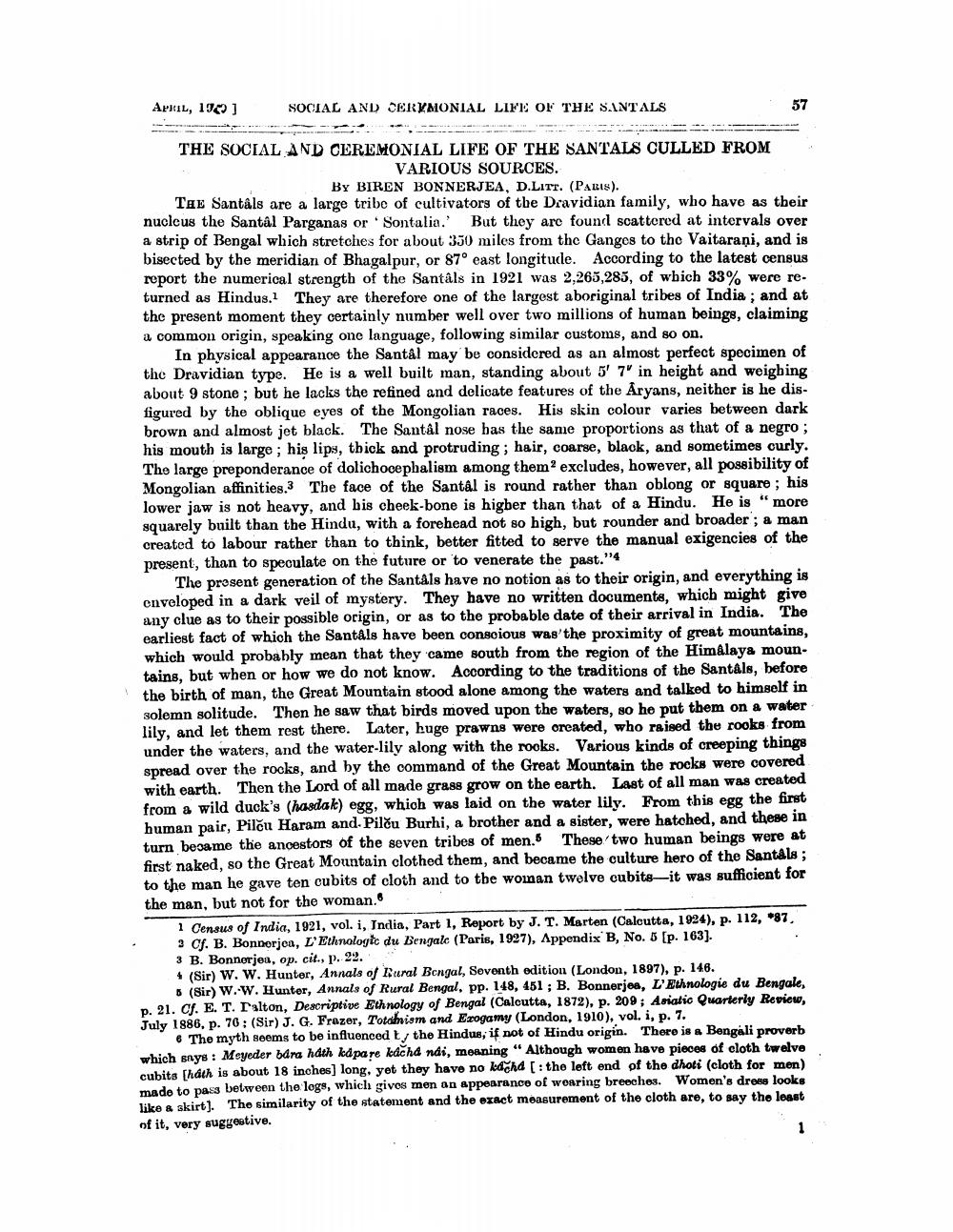________________
APRIL, 1909)
SOCIAL AND CERYMONIAL LIVES OF THE SANTALS
THE SOCIAL AND CEREMONIAL LIFE OF THE SANTALS CULLED FROM
VARIOUS SOURCES.
BY BIREN BONNERJEA, D.LITT. (PARIS). Tae Santâls are a large tribe of cultivators of the Dravidian family, who have as their nucleus the Santal Parganas or Sontalia.' But they are found scattered at intervals over a strip of Bengal which stretches for about 350 miles from the Ganges to the Vaitarani, and is bisected by the meridian of Bhagalpur, or 87° east longitude. According to the latest census report the numerical strength of the Santâls in 1921 was 2,265,285, of wbich 33% were re. turned as Hindus. They are therefore one of the largest aboriginal tribes of India, and at the present moment they certainly number well over two millions of human beings, claiming a common origin, speaking one language, following similar customs, and so on.
In physical appearance the Santâl may be considered as an almost perfect specimen of the Dravidian type. He is a well built man, standing about 5' 7" in height and weighing about 9 stone; but he lacks the refined and delicate features of the Aryany, neither is he disfigured by the oblique eyes of the Mongolian races. His skin colour varies between dark brown and almost jet black. The Santâl nose has the same proportions as that of a negro; his mouth is large ; his lips, thick and protruding; hair, coarse, black, and sometimes curly. The large preponderance of dolichocephalism among them excludes, however, all possibility of Mongolian affinities. The face of the Santál is round rather than oblong or square ; his lower jaw is not heavy, and bis cheek-bone is higber than that of a Hindu. He is "more squarely built than the Hindu, with a forehead not so high, but rounder and broader; a man created to labour rather than to think, better fitted to serve the manual exigencies of the present, than to speculate on the future or to venerate the past."4
The present generation of the Santâls have no notion as to their origin, and everything is enveloped in a dark veil of mystery. They have no written documents, which might give any clue as to their possible origin, or as to the probable date of their arrival in India. The earliest fact of which the Santals have been conscious was'the proximity of great mountains, which would probably mean that they came south from the region of the Himalaya mountains, but when or how we do not know. According to the traditions of the Santals, before the birth of man, the Great Mountain stood alone among the waters and talked to himself in solemn solitude. Then he saw that birds moved upon the waters, so he put them on a water lily, and let them rest there. Later, huge prawns were created, who raised the rooks from under the waters, and the water-lily along with the rooks. Various kinds of creeping things spread over the rocks, and by the command of the Great Mountain the rocks were covered with earth. Then the Lord of all made grass grow on the earth. Last of all man was created from a wild duck's (hasdak) egg, which was laid on the water lily. From this egg the first human pair, Pilou Haram and. Pilču Burhi, a brother and a sister, were hatched, and these in turn became the anoestors of the seven tribes of men. These two human beings were at first naked, so the Great Mountain clothed them, and became the culture hero of the Santals; to the man he gave ten cubits of cloth and to the woman twelve cubits—it was sufficient for the man, but not for the woman.
1 Census of India, 1921, vol. i, India, Part 1, Report by J. T. Marten (Calcutta, 1924), p. 112, 87 3 Cf. B. Bonnerjoa, L'Ethnologic du Bengale (Paris, 1927), Appendix B, No. 5 (p. 163). 3 B. Bonnerjes, op. cit., p. 22. + (Sir) W. W. Hunter, Annals of Mural Bengal, Seventh edition (London, 1897), p. 146.
6 (Sir) W.-W. Hunter, Annals of Rural Bengal, pp. 148, 451 ; B. Bonnerjea, L'Ethnologie du Bengale, p. 21. Cf. E. T. Talton, Descriptive Ethnology of Bengal (Calcutta, 1872), p. 209; Asiatic Quarterly Review, July 1886, p. 76: (Sir) J. G. Frazer, Totahism and Erogamy (London, 1910), vol. I, p. 7.
6 The myth seems to be influenced t, the Hindus, if not of Hindu origin. There is a Bengali proverb which snye : Meyeder bara hath kdpare káčha ndi, meaning "Although women have pieces of cloth twelve cubita (hdth is about 18 inches) long, yet they have no kdchd [: the left end of the dhoti (cloth for men) made to pass between the logs, which gives men an appearance of wearing breeches. Women's dress looks like a skirt). The similarity of the statement and the exact measurement of the cloth are, to say the least of it, very suggestive.




